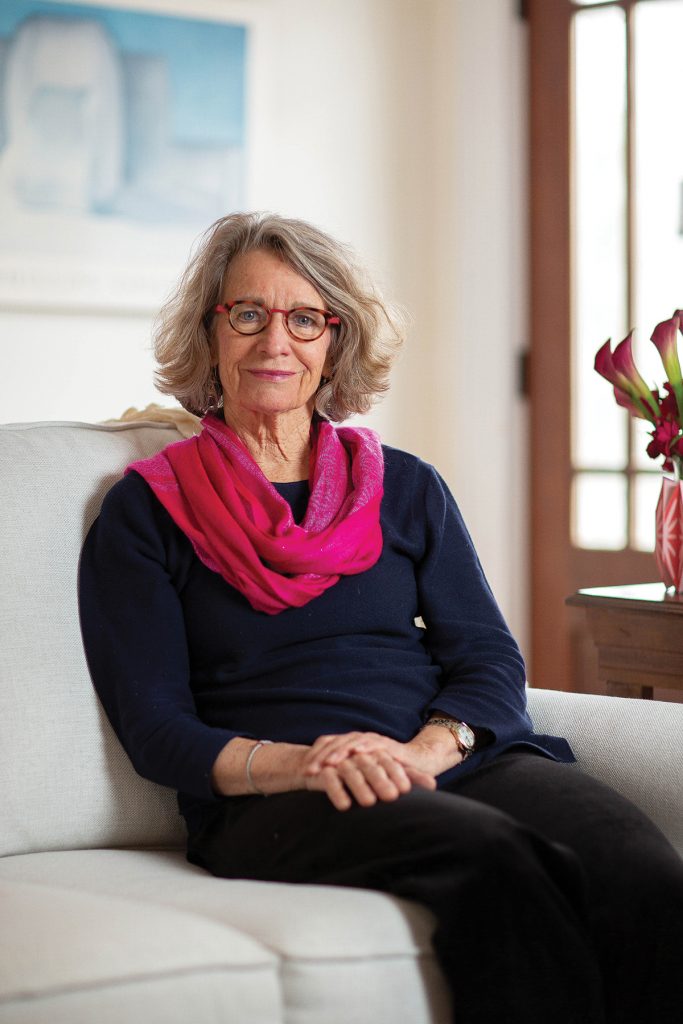
In honor of Asheville’s Zelda Fitzgerald Week, bioethicist Evie Lindemann will talk about how making art can be useful in processing trauma.
Portrait by Colby Rabon
Zelda Sayre Fitzgerald, wife and muse of Jazz Age writer F. Scott Fitzgerald, lived as if she were weightless. In a high-school journal, she wrote, “I ride boys’ motorcycles, chew gum, smoke in public, dance cheek to cheek, drink corn liquor and gin.” It was this contrarian, devil-may-care attitude that attracted and inspired F. Scott. The couple’s public excesses fed their mutual desire for celebrity.
Still, there was a darker, heavier side to Zelda. In 1930, just a year after the stock-market crash would stifle the Fitzgeralds’ posh lifestyle, she was diagnosed with schizophrenia and spent much of the rest of her life institutionalized in Europe and America.
The former flapper eventually perished in a fire on March 10, 1948, while awaiting electroshock therapy at Highland Hospital in Asheville, where she was, at that time, a voluntary patient. Before her untimely death, her only escape from what she called a “bad head” was art: dancing, writing, and — especially in her later years — painting.
Evie Lindemann, an Asheville-based art therapist and bioethicist, says this is often the case for individuals who are living with the effects of mental illness. “Art can help us deal with trauma because it externalizes our experiences,” she explains. “Our experiences take two-dimensional and three-dimensional forms. We can look at them and separate them from ourselves.”
Lindemann is a presenter at the sixth annual Zelda Fitzgerald Week, this year slated for March 8 through March 13 via Zoom. Presented by Aurora Studio and Gallery, a supportive space for creatives who have been impacted by mental-health issues, addiction, or homelessness, the multi-day event celebrates Zelda as an artist in her own right, even though her efforts were overshadowed by her husband’s literary career.
Lindemann’s lecture, “The Shadow and the Sunlight: Managing Internal Struggles with Art,” will reveal how Zelda found solace in creative expression, particularly during her soaring highs and plummeting lows. “Though you are never supposed to diagnose from a distance, Zelda was likely bipolar,” says Lindemann. “And when you’re in a manic episode, you often wonder why the world sleeps — why everyone else looks half awake.”

Kyley Shurrona, the 2020 Zelda Fitzgerald Award winner for creativity and community advocacy, shows off her portrait of Zelda. Kyley is a volunteer with Aurora Studio & Gallery, which sponsors Zelda Fitzgerald Week.
Photo by James Destio
One can assume that Zelda felt isolated living in this altered reality. “But art is a saving grace,” says Lindemann, who spent seven years of her career introducing war veterans to art as a means of coping with trauma. “Art creates a bridge between our internal and external worlds. It creates a bridge from artists to anyone who happens to witness their work.”
During her talk, Lindemann will also present an exhibit by the same name that features artists from Aurora, most of whom are likely to remain unnamed. The artists’ collective desire for anonymity speaks volumes about the stigmatization of mental illness. There’s a great deal of fear when you experience yourself as an “alien presence” in the world, Lindemann notes. There is also a great deal of loneliness. In fact, one of the exhibit’s featured paintings depicts a sense of that intense isolation. But it’s important to realize that, though negative feelings are characteristic of trauma, they are also characteristic of living, breathing, and being.
“We must begin to understand that every human carries emotion,” says Lindemann. “Talking about these feelings, especially if they are odd or bizarre, scares us — but art creates a safe space for discussion. We can see ourselves in art.”
The sixth annual Zelda Fitzgerald Week will be hosted virtually from Monday, March 8, through Saturday, March 13. Evie Lindemann’s presentation, “The Shadow and the Sunlight: Managing Internal Struggles with Art,” is scheduled for Wednesday, March 10, at 7pm. The accompanying art exhibit will be on display through the month of March at The Spotlight Gallery (129 Roberts St., Asheville). For more information, visit aurorastudio-gallery.com.
we are all already in our spacesuits here on earth . . . this my old friend Evie, in a silent pause, knows . . . in His Love, from a WC friend of the heart